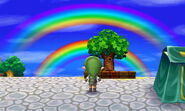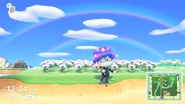| This page is currently under construction. Please help us expand this article by editing it. |
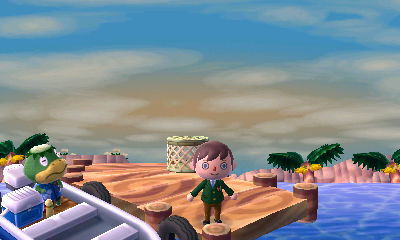
Thin, hazy cloud at sunset in New Leaf.
Weather forms a fairly major visual part of the Animal Crossing series. As with real life weather, it changes often and typically reflects the four temperate seasons - spring, summer, autumn/fall, and winter. Weather and season influence certain bugs and fish to appear. Weather is regularly mentioned by villagers, with rainy weather making them miserable and warm weather making them happy.
The two main forms of weather are precipitation and cloud coverage. Weather also covers thunderstorms, rainbows, and meteor showers.
Weather underwent a substantial improvement in New Leaf. The intensity of rainfall varies more often, and clouds appear differently at different times - for example, during hot weather, light clouds in the sky will appear more brown and "dusty", like a haze, especially at sunset.
In New Horizons, the weather patterns have changed yet again, with more specific details specified at Weather/New Horizons mechanics
Climate[]
The town's climate varies throughout the year.
In January and February, precipitation falls as snow. Snow is settled on the ground. Towards late February, the snow begins to melt, and rain begins to fall.
March and April are the spring months, consisting of moderate rainfall occurring fairly regularly. However, in May and June, things change; this is the rainy season, where rain falls on the majority of days, and thunderstorms are common.
The dry season occurs by early July until September. There is little rain on only a few days a month. Care should be taken to water plants regularly throughout the late summer.
Moderate amounts of rainfall occur regularly in October until mid-late November. Snow flurries occur in late November, but heavy snowfall doesn't occur until early December. Snow falls regularly in December, being slightly more common around Toy Day. In New Leaf and New Horizons, there are snowflakes that can be caught with a net.
Clouds[]
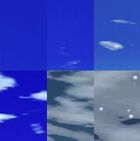
The six cloud stages from City Folk
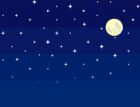
A clear night in Wild World
Clouds are a major visual part of the series. In Animal Crossing, the sky is only seen once on the train, where it is always cloudy. This section only applies to Wild World, City Folk, and New Leaf.
Clouds appear as uniformly shaped ovals in Wild World. In City Folk, they have a more realistic shape, which is kept in New Leaf.
Clouds appear in six different stages of thickness:
- Clear: No clouds in the sky. The sky appears bright blue, or, at night, full of stars.
- Wisp: Similar to clear, but with faint, infrequent specks of white cloud trailing across the sky.
- Light: Noticeable white clouds in the sky, dispersed but still frequent.
- Moderate: Quite substantial cloud cover and a lowered level of brightness. Sky usually still blue in the daytime or starry at night in breaks between clouds.
- Dense: Packed cloud with gaps in coverage. Low level of brightness and lowered visibility. If rain or snow bearing, clouds are steel gray.
- Complete: Heavy and steel gray with only small breaks in cloud. Always bearing rain or snow. Low visibility, horizon appears dull and foggy.
- Thunderstorm: Similar to complete, but rarer and with absolutely no breaks in cloud and a further lowered light level and visibility, with occasional flashes of lightning and rumbles of thunder. Always bearing very heavy rain. Usually occurs during the height of summer.
Clouds appear a dark white in the day, unless they bear precipitation, upon which they are steel gray. Clouds at night are a darker shade of gray, regardless of whether they carry precipitation. Cloud coverage also gives an indication as to what the weather will be like in the coming hours. Dark, thick clouds usually signify incoming rain, whereas light cloud usually means that the skies will be clear later on.
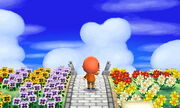
An example of cumulonimbus clouds in New Leaf.
Clouds always blow northwards. This contradicts the fluttering of the town flag and the drifting of balloons through the sky, although this can be explained as that high-level winds are often different from ground-level winds.
In New Leaf, some towering vertical clouds known as cumulonimbus clouds can appear in the sky between the hours of 9am and 3pm in the month of August. They can also appear at any time of year during the island tours. They will appear very large and look like cloud-like mountains in the background.
In New Horizons, Cumulonimbus clouds can also in the summer, similar to New Leaf although they look much more realistic. They start to appear on July 23rd and last until October.
Precipitation[]
Precipitation consists of any form of weather which falls from the sky - in this case, rain or snow. Although rain is the common precipitation for most of the year, in the winter months it is replaced with snow.
Rain falls from around mid February through to early December, whereas snow falls from as early as mid November until late February, although it is only heavy enough to settle on the ground from early December onwards. During portions of November and February, both rain and snow can occur; it could be rainy one day and snowy the next, or vice versa.
Fog[]
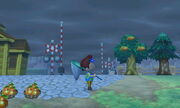
Fog in New Leaf, note the gray tint to the cliffs.
Fog is often a prelude to large thunderstorms. Objects in the distance are shrouded by a faint gray haze. When fog appears rain often follows in the next hour.
In New Horizons, fog will appear in the early morning.
Rain[]

Rain is the second most common weather form, varying in abundance throughout the year. In May and June rain is often thought to be more common, but after July it is often considered a "dry season" where rain is rarer until September.
The presence of rain is necessary for finding Gyroids and Coelacanths. Flowers that are present during this time are watered automatically. During rain, the game's music is changed.
Snow[]
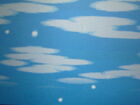
Snow falling slowly in Wild World

A snow-coated town. Note the dense, gray cloud in the sky
Snow is a winter-specific weather form. The first snow can appear in late November, as early as the 25th, and can begin to stick to the ground on December 10th. White snow on the grass melts just before the end of February. Snow is slightly more common around Toy Day - where, in New Leaf, there are giant Snowflakes which can be caught with a Net - but otherwise, there is very little difference in snowfall levels throughout winter. "Thundersnow" doesn't occur, as thunderstorms aren't found in winter.
Settled snow is a feature of winter and appears in the same abundance regardless of visual snowfall, covering the roofs of buildings, trees, rocks and grass. Snowballs are the most important feature relating to the presence of snow.
During snowy weather, villagers may mention the snow or the fact it is cold. Some villagers like the snow, but most of them complain about the cold conditions. As with rain, snow hydrates flowers without the need for a Watering Can. Additionally, the regular themes change slightly for the snow.
Other Weather[]
This section covers any other forms of weather not yet covered, such as rainbows, thunderstorms, and even meteor showers.
Rainbows[]

A rainbow in Wild World.
Rainbows can be seen very occasionally in the sky. They only appear when the sky has cleared very suddenly after many hours of heavy rain or snowfall. They don't occur if the sky clears gradually, nor do they occur at night, but they are more likely to occur after a thunderstorm ends suddenly than any other form of precipitation. Because they always come after many hours of rain, they are more common in the afternoon. Rainbows can appear anytime between 11am - 3pm. Rainbow season starts on the 25th of February and ends on the 25th of November, meaning rainbows are absent for the whole of winter.

A rainbow in New Leaf
The rainbow fills the sky for an entire hour after the end of the rainfall. It starts off weak, before brightening as the hour progresses, peaking at its brightest at about half past the hour. From this point onward, it tends to slowly fade away, before it is completely gone by the beginning of the next hour.
While there is a rainbow in the sky, the chances of 100 Bells dropping from trees is increased.
They appear in all games, although in Animal Crossing, the rainbow appears near a waterfall, as the sky isn't visible in that game.
Double Rainbows[]
Double rainbows occur in New Leaf and New Horizons, and are exceptionally rare. They appear as one bright rainbow with another, slightly fainter, inverted rainbow located directly above it.
Thunderstorm[]

A thunderstorm in New Leaf.
Thunderstorms are a severe form of weather that is present in all games. During a thunderstorm, the clouds are darker and thicker than usual, and the horizon appears foggier than normal. Rain falls more heavily, and flashes of lightning commonly light up the ground, followed by rumbles of thunder.

A thunderstorm in New Horizons.
Thunderstorms can be easy to find, but it depends what time of year it is. During the summer rainy season of May and June, they are very common, usually occurring towards the end of the day. However, outside of this period, they are quite rare. In winter, they don't occur at all, meaning that thundersnow isn't possible.
Meteor Showers[]
- Main article: Meteor Shower
A meteor in New Leaf
Although not technically weather, meteors are treated as such in Animal Crossing. They occur on random nights of the year, starting at 7pm and lasting well into the night. Meteors can be wished on by pressing "A" while empty-handed; the wisher will receive a present from Wishy the Star the next day.
In New Horizons, various types of star fragments will appear on the beaches the next day based on how many stars have been wished upon. These are crafting materials for various Zodiac and Space themed items, including wands. Most of the recipes are taught by Celeste, who will visit the players island occasionally, especially if a large shower will occur that night.
Effect on Wildlife[]
In all games in the Animal Crossing series, the weather, particularly precipitation, influences wildlife in the game.
Fish[]
- Main article: Fish
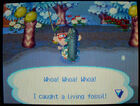
Fishing on a snowy or rainy day is the only way to catch a Coelacanth.
It is generally considered that rain and snow encourage rarer fish to appear in Animal Crossing games, with this weather increasing the chances of fish appearing in general (as indicated by signposts throughout the series). One fish, the very rare Coelacanth, only appears when it rains or snows.
Bugs[]
- Main article: Bug
Many bugs don't appear during rain, such as butterflies, the scorpion, and dragonflies. To the contrary, the snail can only be found when it is raining. Cicadas can still be found when it is raining, but they don't make any noise. This also changes their capture quotes, where the player now remarks on the rain or on how quiet the cicadas are.
The Dung Beetle is the only insect that is dependent on snow to exist – it appears exclusively when snow is on the ground, the reason being that it can only be found rolling snowballs around on the ground.
Flowers[]
- Main article: Flower
Both rain and snow automatically hydrate flowers, without the need for a Watering Can.
Forecasting the weather[]
Weather Warnings[]
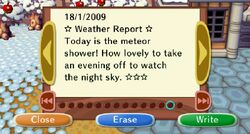
A bulletin notifying the Player of a soon-to-arrive meteor shower on City Folk.
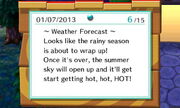
A weather forecast in New Leaf
At the start of each new major weather system, a note is left on the bulletin board to inform the player of its imminent arrival.
- Snow Warning: this weather warning warns of an approaching snowstorm. It appears in early December, two days before snow first settles on the ground.
- New Year Weather: this bulletin provides information on the weather mid-way through winter, in mid January. It contains information about upcoming snow levels, temperatures, and the possibility of ponds freezing over. Despite the warning, water doesn't freeze over.
- May Weather Forecast: this notice appears on the first Wednesday of May. It heralds the arrival of the rainy season, during which it rains regularly and thunderstorms are common. It also states that the temperature will begin to pick up for summer.
- July Weather Forecast: this forecast appears on 1 July. It states that the rainy season "is about to wrap up", and after that it will get "hot, hot, HOT!". It heralds the arrival of the hot, dry season which takes place for the remainder of the summer.
- Meteor Shower: although meteors aren't a weather system, this note is labelled as a "weather warning" on the bulletin board. It appears on the morning of a meteor shower, which occur on random days of the year.

The weather forecast on a modified Robo-TV in New Leaf, predicting sunny weather for the following day
Weather Forecast[]
In addition to the weather warnings, it is regularly forecast on the TV. The weather forecast appears five times a day (starting 6:45am, 7:45am, 11:45am, 6:45pm, and 10:45pm), and last fifteen minutes each. The weather forecast accurately shows what the weather will be like the next day using a symbol, such as a sun, a raindrop, a snowflake, or a lightning bolt. The weather forecast, however, can't show the weather for different times of the day, so it is just a generalization of the entire day's weather. Despite this, it is always correct.
Trivia[]
- Unlike in City Folk, meteors only appear on their own in Wild World. They can be wished upon by pressing the 'A' button when it flashes through the sky. It is only possible to do this when holding no items. This will result in a present being mailed to the Player, containing a spotlight item usually only available from Tom Nook's Store.
- Although technically not weather, a big feature in the sky during winter (while the snow is on the ground) is the Northern Lights. They're always the same and last about in hour in New Leaf, and in City Folk can be seen 8 PM to 10 PM. In New Leaf, they can be seen all winter, but they are more common in early - mid February.
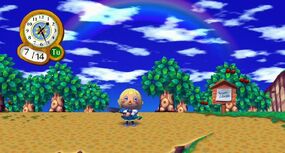
A faint rainbow, as it appears in City Folk.
- In both Wild World and City Folk, the sky clears when a fireworks show is due to take place. Meteors only appear on clear nights as well, and are accompanied by a twinkling noise.
- In the city area in City Folk, the weather is often different to that in the Player's town. Snow doesn't settle in the city, but does on the bus that drives to and from it. If it is raining in the city, the animals there will carry umbrellas.
- Confetti falls continuously from the sky during Festivale in City Folk. On this day, the sky tends to be very clear- any snow fall would conflict with the fall of confetti.
Animal Crossing Rainy Day Theme (Animated Desktop)
- From the 6th to the 8th of April in City Folk and Animal Crossing, blossom from the trees floats through the sky, much like confetti does during the Festivale in City Folk (see above). The sky is clear on these days. On the 9th, trees go green and blossom stops falling.
- In the original Animal Crossing, the music for rainy weather is an arrangement of the main theme; this song plays regardless of the time of day. From Wild World-onwards, a glockenspiel-based arrangement of the current hour's theme plays instead.
- In New Leaf, many weather changes happen on the 25th of November. On the 25th, rainfall switches to snowfall. As well as this, the grass dulls, turning from a deep red to a light brown and the foliage dullens slightly too. And finally, rainbow season ends. All these changes symbolize the end of autumn/fall and the beginning of a new season (winter).
- In New Leaf, the game generates the psuedorandomness for the weather by taking the date, as well as the Mayor IDs.[1]
- When it rains, messages for catching fish or bugs can be different, villagers will react to weather as mentioned, they will comment on the weather, use umbrellas, and smoke puffs will appear when it's cold.
- In New Leaf, the fishing tourney occurs on the 10th of December every couple of years, which prevents the anticipated blizzard from occurring. Despite the lack of snowfall, snow will still be apparent on the ground the following day.
- In New Horizons the game uses weather seeds to generate the weather patterns. When a new island is created, the game chooses 1 seed from over 2 billion possible seeds. A weather seed contains a weather pattern for each day. All the possible weather patterns have an internal name (For example: Fine02, FineRain03, or Rain04).[2]

